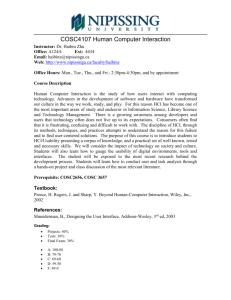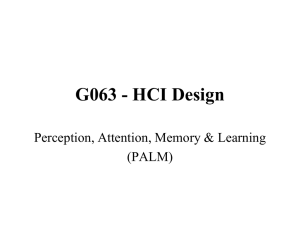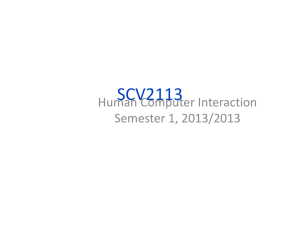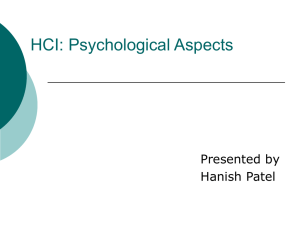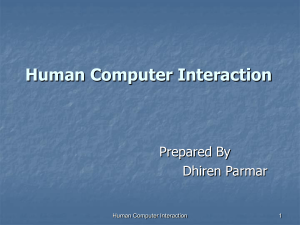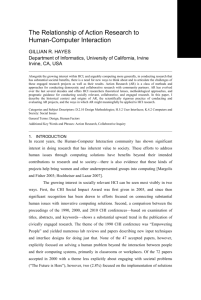Handbook of Human-Computer Interaction
advertisement
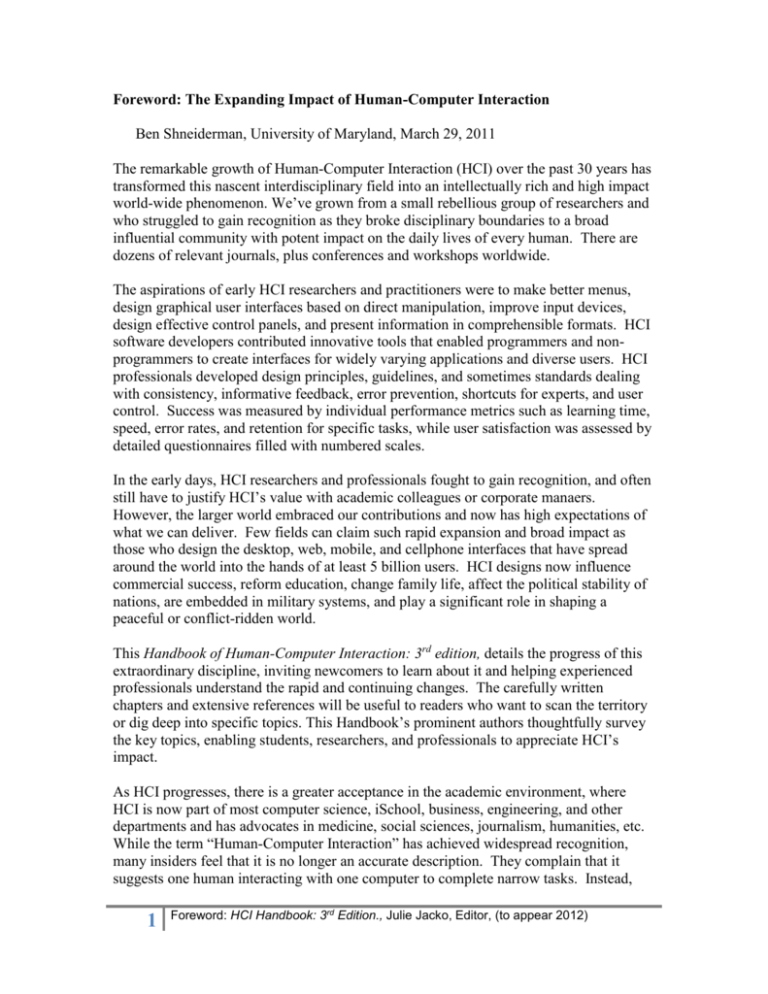
Foreword: The Expanding Impact of Human-Computer Interaction Ben Shneiderman, University of Maryland, March 29, 2011 The remarkable growth of Human-Computer Interaction (HCI) over the past 30 years has transformed this nascent interdisciplinary field into an intellectually rich and high impact world-wide phenomenon. We’ve grown from a small rebellious group of researchers and who struggled to gain recognition as they broke disciplinary boundaries to a broad influential community with potent impact on the daily lives of every human. There are dozens of relevant journals, plus conferences and workshops worldwide. The aspirations of early HCI researchers and practitioners were to make better menus, design graphical user interfaces based on direct manipulation, improve input devices, design effective control panels, and present information in comprehensible formats. HCI software developers contributed innovative tools that enabled programmers and nonprogrammers to create interfaces for widely varying applications and diverse users. HCI professionals developed design principles, guidelines, and sometimes standards dealing with consistency, informative feedback, error prevention, shortcuts for experts, and user control. Success was measured by individual performance metrics such as learning time, speed, error rates, and retention for specific tasks, while user satisfaction was assessed by detailed questionnaires filled with numbered scales. In the early days, HCI researchers and professionals fought to gain recognition, and often still have to justify HCI’s value with academic colleagues or corporate manaers. However, the larger world embraced our contributions and now has high expectations of what we can deliver. Few fields can claim such rapid expansion and broad impact as those who design the desktop, web, mobile, and cellphone interfaces that have spread around the world into the hands of at least 5 billion users. HCI designs now influence commercial success, reform education, change family life, affect the political stability of nations, are embedded in military systems, and play a significant role in shaping a peaceful or conflict-ridden world. This Handbook of Human-Computer Interaction: 3rd edition, details the progress of this extraordinary discipline, inviting newcomers to learn about it and helping experienced professionals understand the rapid and continuing changes. The carefully written chapters and extensive references will be useful to readers who want to scan the territory or dig deep into specific topics. This Handbook’s prominent authors thoughtfully survey the key topics, enabling students, researchers, and professionals to appreciate HCI’s impact. As HCI progresses, there is a greater acceptance in the academic environment, where HCI is now part of most computer science, iSchool, business, engineering, and other departments and has advocates in medicine, social sciences, journalism, humanities, etc. While the term “Human-Computer Interaction” has achieved widespread recognition, many insiders feel that it is no longer an accurate description. They complain that it suggests one human interacting with one computer to complete narrow tasks. Instead, 1 Foreword: HCI Handbook: 3rd Edition., Julie Jacko, Editor, (to appear 2012) these critics believe that the discipline should reflect user-oriented technologies that are ubiquitous, pervasive, social, embedded, tangible, invisible, multimodal, immersive, augmented, or ambient. Some want to break free from the focus on computer use and emphasize user experiences, interaction design, emotional impact, aesthetics, social engagement, empathic interactions, trust building, and human responsibility. New terms have been proposed such as human-centered computing, social computing, human-information interaction, human-social interaction, human-centered informatics, or just human interaction. Novel, but already thriving applications areas include computational biology, computational social science, e-commerce (and m-commerce), digital humanities, information visualization, open government, sustainability, biodiversity, and citizen science. While these broader visions are important, many researchers are still working on innovative display designs, input devices, multimedia output, programming toolkits, and predictive models of user performance. New names and applications are a good sign of success, but finding the balance between sticking with an established term and welcoming innovative directions is difficult. Maybe an old aphorism helps: “make new friends and keep the old, one is silver and the other gold.” Can we retain the brand name recognition of HCI but embrace new directions by discussing micro-HCI and macro-HCI? Micro-HCI researchers and developers would design and build innovative interfaces and deliver validated guidelines for use across the range of desktop, web, mobile, and ubiquitous devices. The challenges for micro-HCI are to deal with rapidly changing technologies, while accommodating the wide range of users: novice/expert, young/old, literate/illiterate, abled/disabled, and the cultural plus linguistic diversity. These distinctions are tied to skills, but there are further diversities in gender, personality, ethnicity, skills, and motivation that are now necessary to address in interface designs. Micro-HCI researchers can take comfort in dealing with well-stated requirements, clear benchmark tasks, and effective predictive models. Macro-HCI researchers and developers would explore new design territories such as affective experience, aesthetics, motivation, social participation, trust, empathy, responsibility, and privacy. The challenges for macro-HCI are to deal with new opportunities across the range of human experience: commerce, law, health/wellness, education, creative arts, community relationships, politics, policy negotiation, conflict resolution, international development, and peace studies. Macro-HCI researchers have to face the challenge of more open tasks, unanticipated user goals, and even conflicts among users in large communities. Although micro-HCI and macro-HCI have healthy overlaps, as do micro-economics and macro-economics, they attract different types of researchers, practitioners, and activists, thereby further broadening the scope and impact. Since commercial, social, legal, and ethical considerations play an increasing role, educational curricula and professional practices need to be updated regularly, and mid-career continuing education for HCI professionals will keep them current. 2 Foreword: HCI Handbook: 3rd Edition., Julie Jacko, Editor, (to appear 2012) An important goal will be to develop new metrics and evaluation methods for micro-HCI and macro-HCI. Moore’s Law has been a useful in charting the growth of computing, enabling everyone to admire and benefit from the increase in gigahertz, terabytes, and petaflops. These are still useful, but we need newer metrics to understand the impact of HCI designs that have enabled the spread of billions of mobile devices and the emergence of YouTube, Facebook, twitter, Wikipedia, etc. Understanding this transformation would be facilitated by measures of giga-hellos, tera-contribs, and peta-thankyous and by newer metrics of trust, empathy, responsibility, privacy, etc. Traditional evaluation approaches of controlled experiments and usability testing are being continuously refined to fit the needs of micro-HCI, while the newer methods of qualitative, ethnographic, and case study methods are being explored to match the needs of macro-HCI. Both groups will benefit from the remarkable increased opportunities to log usage on a massive scale through the increasingly connected communications, data, and sensor networks. Traditional surveys of a small sample of users who offer biased perceptions or reports of attitudes are giving way to actual measurement of usage that reveals the learnability, efficacy, utility, and satisfaction of users. Even more exciting is the potential to capture the manifestations of trust, empathy, responsibility, privacy, security, and motivation. Researchers are also beginning to measure brand loyalty, parental engagement, political leaning, potential for violence, community commitment, and much more. The dangers of inappropriate intrusion, misguided applications, scamming/spamming, deception, and bullying are now part of macro-HCI. Even greater concerns come from criminals, terrorists, and oppressive governments who can use these technologies in ways that threaten individuals, intimidate communities, or destroy the environment. The power of widely used social technologies that stem from HCI’s success means that we will face ethical challenges similar to what the nuclear physicists dealt with during the 1940s and beyond. We cannot and should not avoid these responsibilities. Rather we should embrace them and show leadership in shaping technology to produce positive outcomes. This is never easy, but every worthy project that improves the health, environment, or education of children or builds capacity for constructive communities should be recognized, disseminated, scaled up, and continuously improved. Even more ambitious should be our efforts to promote open government, independent oversight, deliberative systems, and citizen participation. The research agenda for HCI should include the UN Millennium Development Goals such as eradicating extreme hunger and poverty, ensuring universal childhood education, promoting maternal health, and ensuring environmental sustainability. If HCI professionals also courageously address conflict resolution, international development, and peace studies, we can inspire others and help build a better world. We should be proud of what HCI has accomplished, but there is much work to be done. Let’s get on with it! Acknowledgements: Thanks to Ron Baecker, Jack Carroll, Susan Dray, Gerhard Fischer, Rob Jacob, Clare-Marie Karat, Clayton Lewis, Brad Myers, and Jenny Preece for comments on earlier drafts. 3 Foreword: HCI Handbook: 3rd Edition., Julie Jacko, Editor, (to appear 2012)


